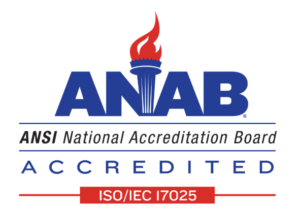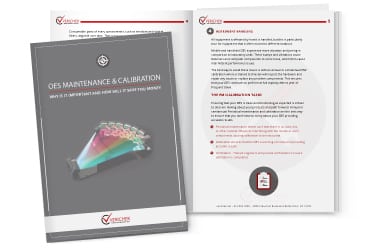
Optical Emission Spectroscopy (OES) uses a lot of terms, and occasionally some of them are inaccurately used interchangeably. Though there are certain similarities, spectroscopy and spectrometry are not the same thing. To better understand what the difference is between spectroscopy vs spectrometry, it is best to start a basic level. This article will discuss the major differences between spectrometry vs spectroscopy, definitions, applications in OES analysis and other frequently asked questions.
A Quick Definition of Spectroscopy and Spectrometry
Spectroscopy refers to the study of how radiated energy and matter interact. The energy is absorbed by the matter, creating an excited state. When the matter is a metal, it is easy to see the interaction of energy and matter because the metal will produce visible evidence, usually as sparks. The interaction creates some form of electromagnetic waves (EM), often in the form of visible light, such as sparks.
Spectrometry deals with the measurement of a specific spectrum. There are four primary types of spectrometry:
Mass spectrometry
Neutron triple axis spectrometry
Ion-mobility spectrometry
Rutherford backscattering spectrometry
Each of these types indicates the type of spectrum being measured. Typically, a spectrometer is used to measure a specific spectrometry.
Essentially, spectroscopy is the study of radiated energy and matter to determine their interaction, and it does not create results on its own. Spectrometry is the application of spectroscopy so that there are quantifiable results that can then be assessed.
More About the Different Types of Spectrometry
Mass Spectrometry
Mass spectrometry (MS) is an analytical technique used to measure the mass-to-charge ratio of ions. It helps identify the amount and type of chemicals in a sample by generating a mass spectrum representing the masses of sample components. This technique is widely used in chemistry, biochemistry, and pharmaceuticals to analyze complex mixtures, study molecular structures, and detect trace elements.
Neutron Triple-Axis Spectrometry
Neutron triple-axis spectrometry (TAS) is used to study the excitations and structural properties of materials at the atomic level. It involves directing a beam of neutrons at a sample and analyzing the scattered neutrons to determine the sample’s energy and momentum. TAS is particularly useful in materials science for studying phonons, magnons, and other collective excitations in crystals.
Ion-Mobility Spectrometry
Ion-mobility spectrometry (IMS) separates ions based on their mobility in a gas under the influence of an electric field. This technique is often combined with mass spectrometry (IM-MS) to provide detailed analysis of complex mixtures, separating ions based on size, shape, and charge. IMS is used in various applications, including proteomics, pharmaceutical analysis, and detecting explosives and chemical warfare agents.
Rutherford Backscattering Spectrometry
Rutherford backscattering spectrometry (RBS) involves bombarding a sample with high-energy ions and analyzing the backscattered particles to determine the sample’s composition and thickness. It is a non-destructive technique used to analyze thin films, measure layer thickness, and determine the elemental composition of surfaces. RBS is commonly used in materials science and semiconductor research.
These techniques each have unique applications and strengths, making them valuable tools in various scientific fields.
Using Spectrometry & Spectroscopy in OES Analysis
OES is the focus on understanding the composition of a particular piece of metal, such as a beam, sheet, scrap, or tool. By using a spectrometer, you can determine the level of excitement in the metal’s atoms to determine what kind of metal it is. This is because the different types of metals create different colors, sizes, and appearance for their sparks. The distinction is incredibly difficult to determine by using just the naked human eye as our eyes are not able to see the fine details.
Usually, you would use a small scrap from the metal you have so that you don’t damage large pieces, frames or other structures made of the metal you want to check or identify.
Once you have the sample piece, it is placed in the spectrometer where the reaction is analyzed and the wavelengths of the generated light are used to make the final determination on the metal’s composition. The result is usually a calculated measurement of the elements within the metal.
There are a number of different types of spectrometers. You should take these into consideration if you are thinking about purchasing a spectrometer because each one has its own pros and cons.
Some will give you remarkable speed but their accuracy may not be as high
Other spectrometers that take longer to deliver the results with higher confidence in results.
Each can have different functions and methods of analysis as well.
Frequently Asked Questions (FAQs)
What is spectrophotometry and how does it differ from other spectrometric techniques?
Spectrophotometry is a method used to measure how much light a chemical substance absorbs by passing a light beam through the sample and measuring the intensity of light reaching a detector. It is commonly used to determine the concentration of solutes in a solution. Unlike other spectrometric techniques that may measure mass or ion mobility, spectrophotometry focuses on the interaction of light with the sample and is widely used in chemistry, biology, and environmental science to analyze various substances.
What is optical emission spectroscopy (OES)?
Optical Emission Spectroscopy (OES) is an analytical technique used to determine the elemental composition of materials. It involves exciting the atoms in a sample to a higher energy state using an energy source, such as an electric arc or spark. As the excited atoms return to their ground state, they emit light at characteristic wavelengths. By analyzing the emitted light, the presence and concentration of different elements in the sample can be determined. OES is widely used in metallurgy, environmental analysis, and quality control in manufacturing processes.
What are the applications for OES spectrometers?
OES spectrometers are widely used in various industries, including metallurgy, for analyzing metals and alloys; environmental science, for detecting trace elements in water and soil; and manufacturing, for quality control and ensuring material compliance with specifications. They are valued for their ability to provide rapid, accurate, and non-destructive analysis of a wide range of elements.

